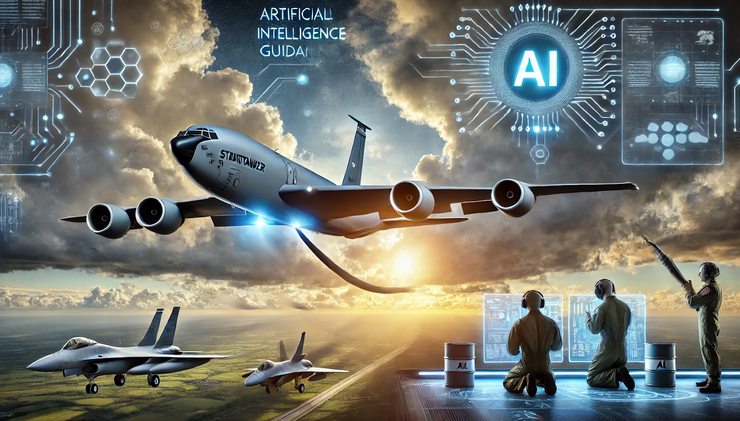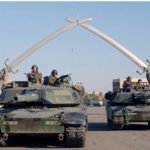(LMT), (NOC), (GD), (RTX), (BA), (PLTR), (AI), (AVAV), (GS)
If you've ever wondered what it's like to teach a computer to fly a military aircraft, I can tell you it's nothing like the flight simulators I used to play with between tours of duty.
I realize this while standing in Merlin's headquarters, watching engineers coax artificial intelligence into managing a 150,000-pound KC-135 Stratotanker - essentially teaching a silicon brain how to perform aerial ballet with what amounts to a flying gas station.
As I watch these AI systems practice their digital dance with multi-million dollar aircraft, I can't help but think of my fellow devil dogs' initial reactions to new tech.
"Sure," they'd say at the Club in San Francisco, drinks in hand, "but can it handle a thunderstorm over the Pacific while running low on fuel?" Fair question from a building full of heroes who've actually done it.
And it's exactly the kind of question that makes General John Lamontagne, head of Air Mobility Command, lose sleep at night.
He's not just wrestling with modernizing a fleet that's older than most of my hedge fund algorithms - he's trying to convince seasoned pilots that their new wingman might be running on silicon instead of coffee.
Between us, this situation that the Air Force faces is what we politely call "resource constraints" - the same kind of diplomatic phrasing I hear when I ask about ammunition supplies in Ukraine.
Speaking of resources, my friends at Goldman Sachs (GS) predict AI investments will hit $200 billion globally by 2025, and the defense industry is particularly eager to get its hands on this tech.
Having straddled both military and financial worlds, I can tell you this convergence is more significant than when we first introduced GPS to ground operations. Let's talk about the major players so far.
There's Lockheed Martin (LMT), the company that never met a military contract it didn't like. They're integrating AI into their systems with the same intensity we used to clear buildings - methodically, thoroughly, and leaving no corner unchecked.
Not to be outdone, Northrop Grumman (NOC) is going all-in on unmanned systems - essentially creating a world where robots teach other robots, which sounds either terrifying or terrific depending on how many Terminator movies you've watched.
Meanwhile, General Dynamics (GD) is taking the measured approach we leathernecks know well: test, verify, then bet your life on it.
Raytheon Technologies (RTX) is busy teaching missiles to be smarter, which is either reassuring or terrifying, depending on your perspective.
Boeing (BA), apparently not content with just commercial aviation's challenges, is also getting in on the military AI game.
And then there's Palantir Technologies (PLTR), which is basically trying to build Skynet, but for good guys (they promise).
Want to know why the defense giants are all-in? The numbers behind all this innovation would impress even the saltiest of gunnery sergeants: the autonomous aircraft market, currently at $6.28 billion, is expected to soar to $22.71 billion by 2030.
That's a 17.8% compound annual growth rate, for those of you who like your metrics with extra decimal points.
But before you go all-in, there are some caveats to consider - because nothing involving both artificial intelligence and military applications could possibly be simple, right?
Defense contracts move at the speed of government bureaucracy, which makes glaciers look like Usain Bolt.
There's also the small matter of ethics - turns out people have opinions about autonomous military systems, who knew?
It's like trying to get everyone to agree on pizza toppings, except instead of arguing about pineapple, we're debating the role of artificial intelligence in national security.
The whole situation gets even more interesting when you throw in geopolitical tensions, which have a way of affecting defense spending much like weather affects ice cream sales - though generally in the direction that makes defense contractors happy.
So, how do we navigate this?
In this complex landscape, smaller companies like Merlin can sometimes out-innovate the big players, much like that scrappy squirrel in your backyard who somehow always defeats your "squirrel-proof" bird feeder.
There are also other emerging players in this field like Shield AI and Anduril Industries - they're proving that agility often trumps size in the race for next-gen defense tech.
You should also keep an eye on the likes of C3.ai (AI) and AeroVironment (AVAV) - they're showing similar potential to reshape military aviation.
While the profit potential in this space is clear, I see something even more valuable: these AI developments could save lives.
Every time I walk into the officers' club, I think about how many future warfighters might be supported by these systems instead of replaced by them.
It's not about removing the human element - any grunt will tell you that's impossible in warfare - it's about giving our people better tools to come home safely.
Because whether we like it or not, the future of military aviation is here. It's got silicon brains, deep learning algorithms, and - thankfully - human hearts still firmly in control. Welcome to your new flight plan.


